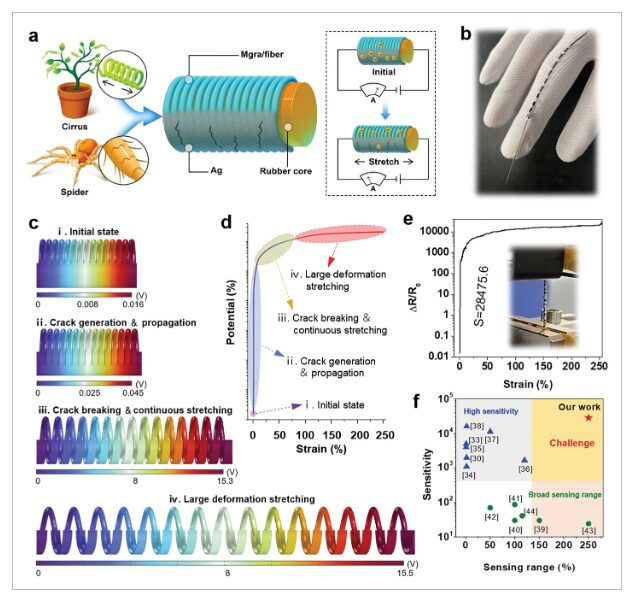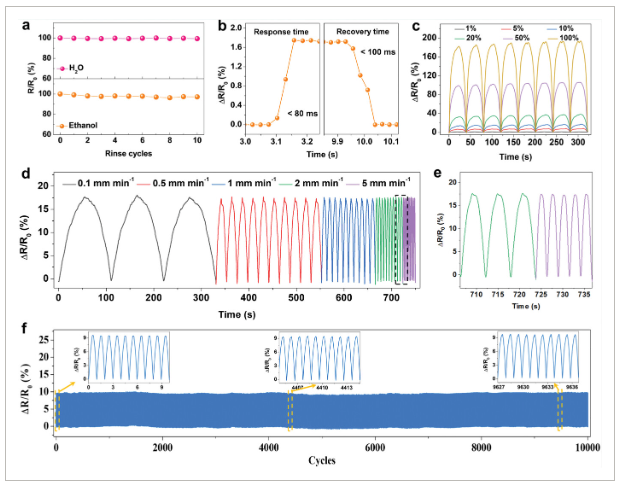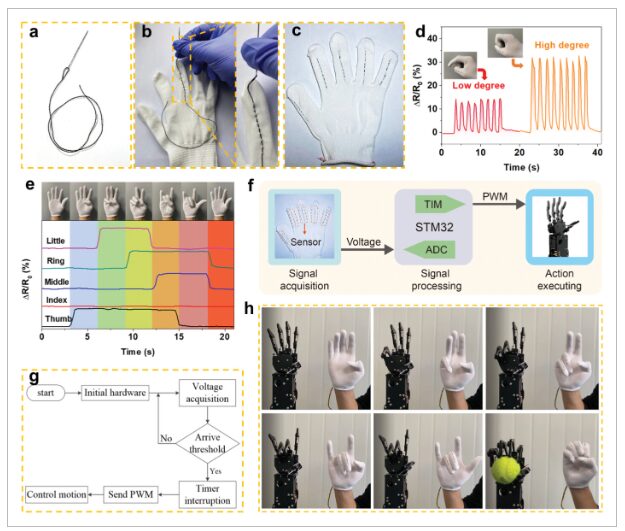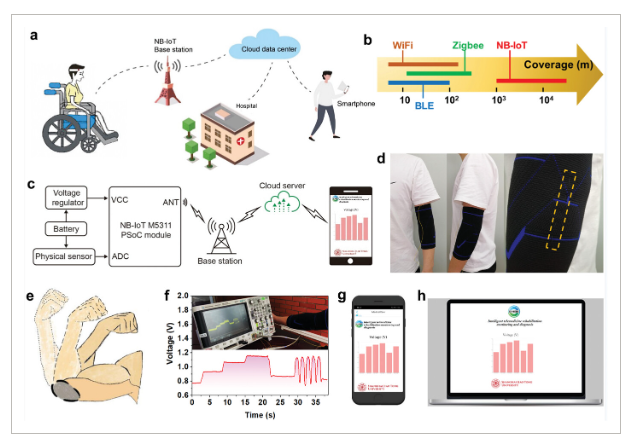
1Introduction to the Results
Real-time remote medical monitoring can address the shortage of public medical resources caused by an aging society. However, the strict requirements for high-performance sensors and long-distance signal transmission hinder the development of such comprehensive monitoring systems. This paper, published by Professor Yang Bin’s research team at Shanghai Jiao Tong University in the journal ADVANCED SCIENCE, is titled “5G NB-IoT System Integrated with High-Performance Fiber Sensor Inspired by Cirrus and Spider Structures” and reports on a biomimetic crack spring fiber sensor (CSFS), inspired by spider legs and tendrils in plants, for stretchable and woven electronic devices.
The outer spring-like polyethylene terephthalate (PET) fiber surface features a multi-layer graphene cross-scale conductive percolation network and printed Ag, achieving a high sensitivity of 28475.6 and a wide sensing range of over 250%. Comsol simulated the electromechanical changes at different stretching stages to explain its response mechanism. Integrating CSFS into fabrics enabled human-machine interaction (HMI) controlled by robots. Moreover, a 5G narrowband IoT (NB-IoT) system was developed in conjunction with CSFS for the collection, transmission, and reproduction of human health data, demonstrating the significant potential of this method in human-machine communication interfaces, smart remote medical rehabilitation, and diagnostic monitoring.
2Visual Guide

Figure 1: Design of the biomimetic crack spring coupled structure fiber sensor (CSFS)

Figure 2: Manufacturing and characterization of CSFS.

Figure 3: Anti-interference stability and electromechanical performance.

Figure 4: Gesture recognition and control human-machine interaction (HMI) system

Figure 5: 5G NB-IoT system for smart remote medical rehabilitation and diagnostic monitoring.
3Conclusion
The authors developed a biomimetic flexible CSFS with high sensitivity and a large sensing range. Using COMSOL, they simulated the electromechanical changes at different stretching stages to explain the sensor’s response mechanism. The woven CSFS is very suitable for integration into wearable electronic devices for HMI and health monitoring, and its multifunctional capabilities have been validated through our sensing and robotic control platform. Furthermore, we integrated CSFS into the existing 5G NB-IoT system for remote medical data collection, transmission, and reproduction, showcasing its tremendous application prospects in the emerging field of efficient remote medical diagnostics. It is hoped that this work will prove valuable in the development of flexible electronics, particularly in human-machine communication interfaces, bringing new opportunities for intelligent remote medical rehabilitation and diagnostic monitoring against the backdrop of an aging society and the increasingly insufficient public medical resources.
References:
https://doi.org/10.1002/advs.202309894
Source: The article is from AS website, compiled and edited by Materials Analysis and Applications.


Copyright and Disclaimer:
① All works marked “Materials Analysis and Applications” on this website are copyrighted by Materials Analysis and Applications. Unauthorized reproduction, excerpting, or use in other ways is prohibited. Works authorized by this website must be used within the scope of the authorization and must indicate “Source: Materials Analysis and Applications”. Violators will be held legally responsible.
② All works marked “Source: xxx (not from this website)” are reprinted from other media. The purpose of reprinting is to convey more information and does not represent the agreement of this website with their views or the authenticity of their content, nor does it bear direct or joint responsibility for any infringement of such works. If other media, websites, or individuals download and use from this website, they must retain the “source of the manuscript” indicated by this website and bear the legal responsibility for copyright and other legal issues.
③ If there are issues regarding the content, copyright, etc., please contact this website within three days from the date of publication, otherwise, it will be regarded as a waiver of relevant rights.